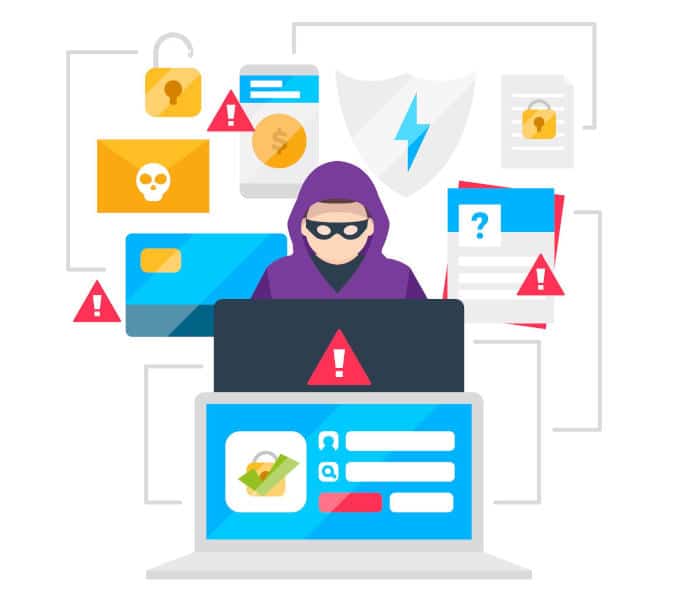A zero-click attack is a cyber attack that allows a computer system to be attacked without the victim even needing to intervene. Find out everything you need to know about this method, which is increasingly used by hackers, how it works and how you can learn to protect yourself!
Traditionally, a cyber attack cannot succeed without the active interaction of the victim. For example, the victim has to click on a booby-trapped link, download malware from an email attachment, or install an application with a misleading title.
However, with the evolution of digital technology and the explosion of the IoT, a new form of attack has emerged. Using this approach, hackers can compromise a system without any intervention from the targeted user.
With the proliferation of connected devices and the increasing integration of digital infrastructures, the opportunities for cybercriminals to exploit invisible vulnerabilities have also greatly increased.
Organised cybercrime groups and state actors are now making increasing use of these offensives, which are gaining in scope and sophistication: zero click attacks.
What is it, and why is it so dangerous?
This is a form of exploitation that takes advantage of invisible or unknown vulnerabilities in a system or application, without requiring any action on the part of the victim. In other words: no clicks.
Technically speaking, these attacks often exploit what are known as “zero-day” vulnerabilities. These are security flaws that are still unknown to developers or users.
They can be exploited by cybercriminals to execute malicious code, install spyware, steal sensitive data or compromise the integrity of a system without the user even realising it.
The power of these attacks lies in their ability to operate in the background, leaving no visible trace of their presence. They can target any device connected to the Internet, from smartphones and PCs to the critical infrastructures of businesses and governments.
By exploiting invisible attack vectors and bypassing traditional security measures, zero-click attacks represent a serious and growing threat to global cyber security…

Methods commonly used by hackers
To infiltrate systems and compromise data discreetly, hackers can employ a number of techniques. As mentioned above, the most common is the exploitation of zero-day vulnerabilities.
Attackers actively seek out unpatched security holes in popular software and operating systems, such as Windows or Linux, and then exploit them to execute malicious code under the victim’s nose.
The target often has no chance of defence or proactive reaction. However, other approaches can prove just as formidable.
In addition to zero-day vulnerabilities, hackers can also exploit weaknesses in existing systems and applications. These can include obsolete software, neglect of security patches, or even insecure default configurations.
A zero-click attack can also involve social engineering methods such as creating fake WiFi networks, sending phishing messages, or deploying fake software updates to trick users into downloading malicious code.
These various options have enabled cybercriminals to become more skilful and effective in their quest to exploit invisible vulnerabilities and carry out attacks on an ever larger scale.
What are the real consequences of a zero click attack?
At first sight, you might think that the impact of a zero-click attack is not so catastrophic. In reality, it can have dramatic repercussions for both individuals and organisations.
This type of attack can lead to massive data theft, compromising the confidentiality and security of personal information.
Users may find themselves the victims of identity theft or financial fraud, or see their sensitive data sold on the black market…
What’s more, these attacks can compromise the integrity of devices, leaving smartphones, computers and other devices vulnerable to future exploitation.
For businesses, the consequences can be massive financial losses, high remediation costs and potential damage to reputation.
A single zero-click attack can paralyse all business operations, compromise intellectual property, and expose customers and partners to increased risks.
Organisations can also face severe regulatory penalties for non-compliance with security and data protection standards.
Beyond these consequences, these attacks pose major challenges in terms of national security. If a critical infrastructure, a government system or a communications network is compromised, the stability and security of an entire country is put at risk.
As a result, a cyber attack can have geopolitical implications, provoking tensions between nations and exacerbating threats on an international scale.

How can you protect yourself against this scourge?
As you can see, in the face of this growing threat, it has become essential to put in place robust prevention and protection measures to ensure that systems are properly resilient and secure.
A strict security policy is essential within a company, with the regular application of security updates and patches. Adopting a multi-layered approach to protecting infrastructures and devices is also imperative.
This includes the use of advanced security solutions, ongoing employee training, and proactive monitoring of potential threats.
Investing in advanced monitoring and detection tools has also become an imperative.
These solutions can help identify and mitigate zero-click attacks before they cause irreparable damage.
Intrusion detection, behavioural analysis and incident response systems can provide a rapid and effective response to emerging threats.
In cybersecurity, as in any other field, prevention is better than cure. Adopting a proactive approach therefore involves strategic planning and ongoing preparation.
It is essential to assess the risks, put in place robust security policies, and create a genuine organisational culture focused on security.
Simulation exercises, security audits and penetration tests all help to identify potential vulnerabilities and strengthen the overall security posture.
Knowledge is a weapon, but it can also be a shield. That’s why employees need to be trained and made aware of best security practices, the risks associated with cyberthreats and the preventive measures they can take to reduce the risk of zero-click attacks and exploitation by malicious actors.
However, defending against hackers goes beyond a single organisation and requires collaboration between the public and private sectors against this terrible threat.
Sharing information on threats, indicators of compromise and attack techniques can help all businesses anticipate risks, develop response strategies and help curb global cybercrime.
Conclusion: zero click attacks, a cyber threat as discreet as it is dangerous
Ever more formidable and sophisticated, zero-click attacks are evolving very rapidly and pose a serious threat to cyber security on a global scale.
Invisible and insidious, they put individuals and organisations at risk, as well as critical infrastructures and even the national security of entire countries.
Companies need to adopt preventive measures, invest in advanced detection technologies, and train their staff to identify and thwart this type of attack.
To acquire this expertise for yourself or your employees, you can choose DataScientest. Our cybersecurity analyst training course enables you to learn how to protect yourself against all forms of cyber attack!
This course teaches you how to analyse data to detect security incidents, recognise the types of attack, draw up an alert report recommending the measures to be taken, and design a technology watch system.
After a review of the fundamentals of systems and networks, you will be given an introduction to cybersecurity and SOCs. You will learn about techniques such as cryptography, the use of a VPN and the SIEM software Splunk.
The programme also looks at ethical hacking, covering the various intrusion test methodologies and techniques used by hackers.
The course is rounded off with a core project to put theoretical knowledge into practice, and an attack simulator for total immersion in a real-life situation.
At the end of the course, you can receive a training certificate from Paris La Sorbonne University and SIMPLON’s “Analyse detected security incidents” certification.
The entire course can be completed remotely in a BootCamp over a period of 11 weeks, or part-time over 9 months. Our organisation is eligible for funding options. Find out more about DataScientest!











